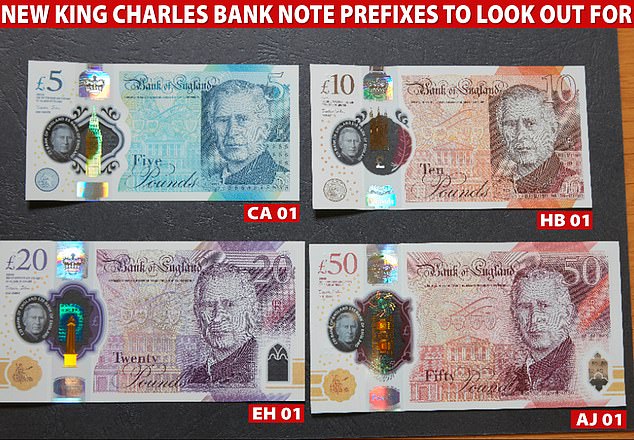New bank notes showcasing King Charles III are being introduced into circulation starting today. This significant event marks the first time notes featuring the new monarch replace those of the late Queen Elizabeth II. This change represents a decade-long effort in design, logistics, and planning.
Historic Introduction of King Charles III Notes
King Charles III becomes only the second monarch to appear on Bank of England notes, following Queen Elizabeth II in 1960. Despite the updated portrait of the King, the reverse side of the notes remains the same as before.
Revealing Prefixes and Serial Numbers
Today, we can disclose the prefixes and serial numbers of the first batch of £5, £10, £20, and £50 notes featuring King Charles. Each banknote includes a unique serial number with a four-digit prefix. The initial prefixes and serial numbers are:
- £5: CA 01 000001
- £10: HB 01 000001
- £20: EH 01 000001
- £50: AJ 01 000001
Exclusive Possession of First Printed Notes
The first printed notes with these serial numbers are not available to the public. These notes were presented to King Charles himself on April 9. According to the Bank of England, these new notes continue the polymer series, maintaining sequential serial numbers from the last batch featuring Queen Elizabeth II.
Collectible Value of Early Serial Numbers
Notes with early serial numbers are expected to be highly valuable, much like the AA01 polymer £5 notes featuring Sir Winston Churchill, which became highly sought after. Many Britons plan to keep their first King Charles note as a collectible or potential investment.
Public and Collectors’ Anticipation
A survey by Coventry Building Society reveals that a significant portion of the population intends to keep these notes for their collectible value. 15% of respondents plan to sell the new notes on platforms like eBay or at auctions.
Circulation and Availability of New Notes
While the Bank of England cannot confirm if the CA01, HB01, EH01, or AJ01 notes are in circulation today, they are expected to appear in the coming weeks and months. Collectors and the public can also acquire these notes through a charity auction hosted by Spink & Son.
Upcoming Charity Auctions
The Bank of England will hold charity auctions for the new banknotes. The first auction for £5 notes will be on June 13, followed by £10 notes on June 27, £20 notes on July 11, and £50 notes on July 25. Previously, a £5 note with the serial number AA01 000017 sold for £4,150.
Auction Expectations and Collector Insights
According to Spink & Son, notes with exceptionally low serial numbers are expected to fetch high prices at auction. For instance, a £5 note could sell for between £250 and £500, while £10 and £20 notes might go for £500 to £1,000. The value of a £50 note could reach several thousand pounds.
Historical Context and Previous Batch Prefixes
The last batch of notes featuring Queen Elizabeth II was printed in various years: £5 notes in July 2018, £10 notes in December 2020, £20 notes in October 2022, and £50 notes in April 2022. These notes had the following prefixes: £5 (BC60), £10 (EM54), £20 (DM45), and £50 (AE80).
Collectibility and Value Preservation
Notes with low serial numbers should be kept in mint condition to maximize their value. Collectors highly covet such notes, and historically, low denomination serial numbers have ended up with the Prime Minister and the Chancellor.
Coveted Notes and Collector Preferences
Notes with special serial numbers, such as those matching birthdays or containing significant numbers, are particularly sought after by collectors. In countries like China and Japan, notes featuring the number eight are especially popular.
Selling Notes on eBay and Auction Trends
While some people may buy notes to resell them, veteran collectors typically hold onto notes with the lowest serial numbers. The market for the new polymer £5 Churchill notes in 2016 saw many such notes sold at a premium on eBay.
Usage and Popularity of New Bank Notes
Despite the rise of contactless payments, 97% of Britons continue to use cash. The £10 note is the most favored, particularly among those aged 25 to 34, who are likely to keep new notes as memorabilia or for future sale.
Bank of England’s Commitment to Cash
Andrew Bailey, the Bank of England’s Governor, emphasized the importance of cash and the historic significance of introducing new notes featuring King Charles III. He assured the public of the Bank’s commitment to providing banknotes as long as there is demand.
Breaking News
TDPel Media
This article was published on TDPel Media. Thanks for reading!Share on Facebook «||» Share on Twitter «||» Share on Reddit «||» Share on LinkedIn
